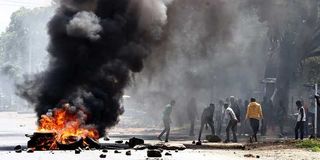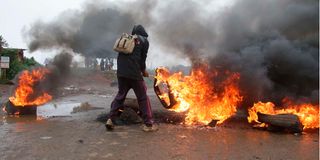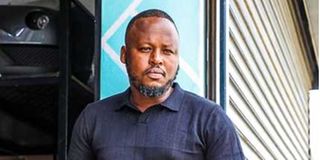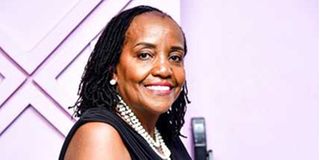
Demonstrators light up fire on Juja Road at Mathare Kwa Chief on March 27,2023 during anti government demonstrations.
Confusion, anger, uncertainty, and frustration are common feelings parents experience at heightened levels during times of civil unrest, war, violence, or political or social upheaval.
It is often difficult for parents and guardians to know how to support their children during such times, as they may also feel overwhelmed and confused.
They are caught between guiding their children through a tumultuous period of life — which can sometimes be extensive and with serious consequences such as destruction, displacement, or even death — and managing their own emotions.

A protester stokes the flames of a bonfire lit by protesters on the Nyeri–Nairobi highway in Karatina town during the Saba Saba protests on July 7, 2025.
Addressing this requires having well-considered, age-appropriate, honest, and candid conversations with their children. Professional counselling and therapy may also be needed, as the aftermath of these events can leave a lingering trail of anxiety, trepidation, and fear.
Over the past year, Kenya has found itself in such a situation. Inadvertently, parents have had to step up as primary counsellors and conversation starters to navigate through the unprecedented realities they face.
Purity Wanjiku, 28, is a mother to a six-year-old daughter. Over the past year, she has had several discussions about what has become known as the Gen Z Revolution. As a Gen Z herself, she has participated in numerous protests to add her voice to the thousands who take to the streets when called upon.

Purity Wanjiku, a mother of a six-year-old daughter always informs her child when she takes part in street protests.
“I had several sit-downs with my daughter about the protests. On the days I left home for the streets, I notified her as much.”
Purity believes in speaking clearly and maintaining an open-book style of parenting, so it’s understandable why she shared with her daughter about her involvement in the 2024 protests. Her daughter asked her about her level of involvement during their first sit-down.
“Children see what is happening in their country. At times, as parents and guardians, we get self-absorbed in our adult bubbles and forget that children are human beings too, with brains, eyes, and emotions. It’s true, some may not be fully developed to grasp the entire subject matter, but they understand things in small doses and on matters that directly affect them. If they can’t go out to play because of ongoing gunfire and screams, if they can’t go to school because the roads are blocked, that becomes an issue of interest to them,” she explained. This approach fosters honesty and understanding, allowing children to process complex issues within their capacity.
To effectively convey her message and give it significance, Purity clarified the motive behind her involvement and that of many others across the country. “I took her through an age-appropriate overview of governance and leadership and connected it to the process that led to the increased activities in the streets.”
It’s no surprise that Purity didn’t feel inadequate when having this tough conversation with her daughter. “I explored an angle I was sure would be easy to understand. I practised great calmness while explaining information to her because it’s easy to get angry when going through the very things that cause anger and pain. Explaining to your child and bearing your pain multiple times is especially a difficult part of the process. I am fortunate because I didn’t struggle with most of the concepts since my daughter already had an idea why there was civil unrest in the country, and understanding that made it quite straightforward.”
Protests
Purity has sat on the front row of her daughter’s emotional turmoil each time there’s a planned protest. “She knows that people die in the protests, she knows that people get arrested, and this is a scary part for me as a parent, to know that my child could be imagining losing me violently. The other day she ‘warned’ me not to step out of the door because she didn’t want to lose her mom.
Her fears are justified, and her admonishment is welcome. But it stands at a critical intersection of duty and fear, on one hand, the adult in you wants to exercise your civic duty, on the other, you admit that it could get violent, you could get killed or sexually assaulted. You imagine what could become of your child’s life if you stopped a bullet in the streets.”
To protect her well-being for now, Purity has had to switch off the TV to avoid piling more coal on the fire that is already out of control. “The mental impact on me as an adult is so hard that I had to take intermittent social media breaks. I can only imagine what adding to what she’s already seen and heard can do to her.”
Purity admits that this is just a stopgap measure and may not work in extended periods of unrest because somehow, “the spillage has a way of ending up at your doorstep.”
Even then, Purity believes that parents must find a pivot on which to balance the truth, in its ugliest form and content, and the duty to shield, guide and guard their children through and against damaging information that could have far-reaching effects as they grow.
Davis Maina, 33, has seen firsthand how unrest can damage a child. He has a vivid image of violence etched in his mind from the post-election violence that bedevilled the country about eighteen years ago. “I still remember death and destruction, the burden borne by a community in the wake of wanton recklessness.”

Davis Maina is a father of two aged 11 and 12 years. He witnessed post-election violence as a child and it haunted him.
Davis remembers this burden because he is now a parent to two children aged 11 and 12. “Back then, nobody talked to us young people, nobody talked to the children in the community, even though we all were part of those affected by the destruction, displacement and the air of volatility the skirmishes left behind. I think our parents assumed that just because we were children, we could not process it.”
Davis is careful not to remodel or recreate such a mistake. He calls it a mistake because he believes some of his agemates never recovered from the things they saw then. “I believe if we got the right guidance on how to process the whole fiasco, some people would not be pulling a chain of trauma by their heels behind them today.”
Children today, Davis says, unlike in the past, have broader access to information. “My daughter knows of the many children that have died from stray bullets over the years occasioned by civil unrest witnessed in the country.”
What happens when a child tells their father they are afraid they could get injured or even killed if they went to play outside during such times, as is the case with Davis? “As a parent, you learn so many things on the job. One of those things is become a safe space for your children. I listen to my children and interrogate their understanding of what is happening. How much they know and sieve through what could be true, what could be misinformation because again, they get their information from internet sources and the internet is awash with misinformation. Listening to them and unpacking what they have to say has been my biggest go-to strategy. Only then am I in a position to gauge their distress, their fear and level of anxiety and know what I can do to help them.”
There are days he has had to stay at home during working hours. “My physical presence for them acts as a fortified sense of security, you can tell they are calmer when I am home, especially on days when the streets are ugly. Their fear, I have come to see, is twofold: they are afraid that I could be harmed while going to work. They also fear that in my absence, nobody will be there to protect them.” In this, competing interests ensue—fending for his family and reassuring them in terms of physical presence. Davis has learned to walk the high wire to keep a balance.
“As a businessman, every day I open shop counts; similarly, every day I can be there for my children is immeasurably important. So, I have been talking to them, leading them to understand that I am there even when they can’t see me. I keep my communication channels open. I will be on the phone with them numerous times during the day to check on them and assess their status.
This is important because it lifts off their fear and creates an element of assurance; they know that in case of anything, I will find my way to where they are. We have moved houses as well to an area I think is less susceptible to sporadic violence”
Davis believes that both parent and child should seek professional help when it gets worse. “Your children see you as this superhero that is impregnable. In a way, there is some truth in their thoughts. But it is a bubble you must not live in yourself. You also need help; you also need to process what you are feeling and going through. These events are happening as we all watch, you are not immune because you are a parent and more specifically, as a father. I wish we had a community debrief from, say, humanitarian organisations, every time this happens. This could help parents and children process first-hand trauma. “

Margaret Ndugi Njihia is a clinical psychologist and child therapist at the Technical University of Kenya.
Margaret Njihia, a clinical psychologist and child therapist currently working at the Technical University of Kenya, shares insights on how children are affected by civil unrest, political instability, and violence, and what parents can do to support them.
“First, it is important that we define trauma as anything that is overwhelming and leaves the child at a state where they are feeling completely overwhelmed, like a near-death experience, helpless, hopeless, anxious, and defeated.”
She categorises trauma into primary experiences (what happens directly to the child) and secondary experiences (what the child witnesses or hears about). “You may not have been there, but you saw it in the media, heard people screaming, or even inhaled tear gas from your balcony. That’s secondary trauma,” she explains. “And that’s how children suffer vicarious trauma.”
Honest dialogue
So, how does one start addressing this possible trauma? “Start with a debrief, ask them, ‘What have you seen? What have you heard? What do you think is going on in our country?’ Then fill in the knowledge gap — age appropriately.” Margaret emphasises that helping children process their fears starts with reassurance and honest dialogue, not denial, because even though they are young, they are alive to the events around them. “Use age-appropriate language,” she adds. “What you’ll tell a 14-year-old is not the same as what you’ll say to a five-year-old.”
Further, Margaret offers actionable steps that can help both child and parent sail through the storm: “Start by having honest conversations with the children using age-appropriate language. Be as honest as possible. Then, prioritise physical safety. Even if I’m living in an informal settlement, how can I prioritise the child’s safety?
Secure your home. Know which room is the safest. Lock doors, close windows.” She adds that homes should have emergency plans: “What if something happens and you’re not home? Who can the child call? Are the numbers visible? Are phones charged?” She is afraid that this is not a common practice in many households. “If you did a random survey today, how many homes have emergency contacts visible to the child or even to the nanny? Very few.”
Limiting exposure is another step a parent can take to help their children in distress. “Children’s brains are not fully developed to analyse or filter information as an adult would,” she warns “Control media consumption, filter conversations, stop discussing worst-case scenarios in their presence.”
Social and mainstream media are probable channels through which children consume information. Your child can stumble upon graphic media, at times without a disclaimer for viewer discretion. This, she says, can be unsettling and may induce feelings of anxiety and fear.
It is prudent that parents remain on high alert about behaviour change as well “Watch for changes in behaviour and monitor signs of distress, this may include a change in sleeping or eating patterns, sudden anxiety when a phone rings, hiding, or refusing to go to school — possible signs of trauma.”
Additionally, it is important to maintain routine and familiarity. “Routine gives children a sense of predictability,” she explains. “Mealtime, bath time, bedtime — keep them consistent. Stick to familiar environments where possible.”
This creates a sense of stability, Margaret advises. As a parent, model calmness, “Are you modelling calmness, or are you the one who needs more help than the child?” she poses. “Children must feel like they can come back to you for support.”
Family all-inclusive activities can help children unplug from the prevailing distress and reconnect. “Families can participate in fun activities such as hikes, walks, swimming, knitting, artwork (painting/ drawing), cooking, table games like Scrabble, playing cards, reading story books, or even telling stories.” This removes them from the chaos, even just for a moment, and centres their focus on their sense of togetherness and resilience in the face of instability.
Lastly, seek help for the child and the parent. Margaret encourages parents not to fear therapy, especially when they feel overwhelmed. “If I feel I’m not effectively helping the child or I’m struggling because this reminds me of my past — that’s the time to seek professional help.”
Therapy, she explains, could be individual or family-based. “Sometimes what we see as anger in adults is unprocessed trauma from childhood,” she notes. “The adults we have today are shaped by the childhoods we had in the past.”





